Just the name “reverse mortgage” suggests that this type of mortgage works a little differently than more common mortgage types. Here’s what you need to know about how a reverse mortgage loan works.
What is a reverse mortgage?
A reverse mortgage is a loan that lets eligible homeowners tap into a portion of their home equity without selling their home. Borrowers choose how they receive proceeds either as a lump sum, monthly payouts, a line of credit, or a combination of the three.
Traditional vs. reverse mortgage comparison
With a traditional mortgage, borrowers take a specific amount of money to purchase a home. They make monthly payments with interest toward the loan balance for a predetermined term. Standard terms are 10, 15, or 30 years. Though they owe the lender a certain percentage of the home’s value, they fully own the home. The loan will be paid off by the end of the term, assuming the borrower makes all agreed-upon payments.
Although you can purchase a home with a reverse mortgage, people more commonly use reverse mortgages to access equity in homes they own. Like with a traditional mortgage, a reverse mortgage borrower always retains ownership of the house. But unlike the traditional mortgage, the reverse borrower is not required to make monthly mortgage payments. They are, however, still responsible for paying property taxes, homeowner’s insurance and other charges related to property ownership like HOA dues as part of the terms of their loan.
Why people take out reverse mortgages
Another way that a reverse mortgage is different from a traditional mortgage is the flexibility it offers borrowers to use it in a way that suits their needs.
Borrowers may use their funds in virtually whatever way they choose. Some of the most common ways people use reverse mortgages are to:
- Increase Cash Flow. In addition to allowing people to tap into a portion of equity through monthly payouts with a home equity conversion mortgage (HECMs), the removal of monthly mortgage payments with a reverse mortgage offers increased cash flow.
- Pay Down Higher-Interest Debt. Borrowers saddled with high medical bills, credit card debt, or another substantial financial obligation may find a reverse mortgage offers them the ability to get out from under their higher-interest debt.
- Help heirs now. Reverse mortgage borrowers can use the proceeds to help a grandchild get through college or make another gift to their heirs during their lifetime.
- Do something for yourself. In retirement, cash flow may be tight in certain seasons, but with a reverse mortgage, borrowers can have the freedom to take a much-needed vacation, home renovation, or something else without withdrawing from savings or cashing in other assets.
Eligibility requirements for a reverse mortgage
To apply for a reverse mortgage, borrowers must certify that they have undergone reverse mortgage counseling through a Housing and Urban Development (HUD) approved agency. This counseling ensures that the borrower fully understands the terms of their mortgage and what they are agreeing to.
In addition to the mandatory counseling, at a minimum the borrower must meet the following requirements to be eligible for a reverse mortgage:
- Borrowers must be 62 years or older for HECMs. Ages for proprietary reverse mortgages can vary. In some states, borrowers can take proprietary reverse mortgages at 55.
- Borrowers must be able to meet financial obligations. Although borrowers don’t make required monthly payments on their reverse mortgage, they are responsible for property taxes, home association dues, and insurance. Borrowers must also have the means to maintain the condition of the property at an acceptable standard. A financial assessment the lender conducts as a part of the application process will help determine if borrowers can meet these obligations.
- Borrowers must live in the home. A home must be a borrower’s primary or principal residence. That means they typically reside in the house for most of their time. Borrowers must certify annually that they still live in the home.
- Borrowers must have substantial equity in the home. There is not a set percentage of equity a borrower must have to be eligible. Generally, lenders require 50% or more.
It’s not enough for a borrower to meet the qualifications of a reverse mortgage; the property must also be eligible.
What homes are eligible for a reverse mortgage?
Broadly, single-family homes are eligible for a reverse mortgage. The definition of a single-family home can cover a variety of structure types. According to the Federal Housing Administration (FHA), a single-family home is a stand-alone unit or one attached to a building. This definition includes:
- Manufactured homes and townhomes affixed to a foundation.
- Duplexes, triplexes, and fourplexes if the borrower lives in one of the units.
- FHA-approved condominiums. Borrowers can determine if they have an approved condo by checking the Housing and Urban Development (HUD) website.
HUD considers buildings with more than five units commercial properties, and they are not eligible for a reverse mortgage.
What are the loan terms of a reverse mortgage?
Because reverse mortgage borrowers don’t make required monthly mortgage payments to their mortgage until the loan comes due, staying on good terms with a reverse mortgage is relatively simple.
- Borrowers can keep their loan in good standing by complying with the following terms:
- Staying up to date and current on property taxes, homeowner’s insurance, and other home-related fees, such as HOA dues.
- Living in home as their principal residence.
- Maintaining the home and keeping up with necessary repairs.
As part of complying with the terms of the mortgage, reverse mortgage borrowers must sign an affidavit annually to verify they still reside in the home. Every year, the loan servicer will send borrowers a home occupancy certificate to their primary residence. Borrowers must sign and send the certificate back within 30 days of receiving it.
If a borrower fails to comply with the terms of the reverse mortgage, they risk default and the loan may come due and payable. Anyone struggling to meet the terms of their mortgage should communicate with their servicer early on.
What do borrowers pay with a reverse mortgage?
While reverse borrowers do not make required monthly mortgage payments, they do need to keep up with home repairs, home insurance, and property taxes. Income taxes aren’t levied on reverse mortgage loan proceeds because the IRS considers reverse mortgage payout loan proceeds, not income.
Though there are no required monthly mortgage payments, borrowers can choose to pay down the balance as they see fit.
When taking out the loan, borrowers must pay a counseling and appraisal fee, as well as other regular closing costs and fees, many of which borrowers can pay with loan proceeds. Interest and mortgage insurance premiums accrue on the loan balance monthly. The borrower does not need to make monthly mortgage payments until the loan comes due, at which point the full amount of the loan plus accrued interest and mortgage insurance premiums must be paid.
Natural disasters and other unexpected events
Homeownership involves several risks that even the most conscientious homeowner can’t eliminate. If your home is in a specific disaster-prone area, adequate insurance coverage is essential. As a reverse mortgage borrower, should your home be damaged or destroyed by fire, flood, or some other unforeseen event, your insurance coverage will be instrumental in rebuilding. It is also essential that you notify the loan servicer immediately. If you intend to rebuild or bring the house back to its previous state, you will stay in good terms with the reverse mortgage.
How much money can you get from a reverse mortgage?
Several factors determine how much money you can borrow through a reverse mortgage. Those factors include your age, the interest rate offered, the home’s value, and how much equity you have in the home. A reverse mortgage calculator will estimate how much money could be available to borrow and your remaining equity. The borrower must supply their age, home value, and any current mortgage balance, if applicable.
Borrowers can receive money as a lump sum, monthly payouts, a line of credit, or a combination of all these options. The best course of action will depend on the individual financial situation and strategy.
Payout limitations
It is worth mentioning that all HECMs are subject to the 60% utilization rule. This limits the amount any reverse mortgage borrower can take in the first year to the higher of 60% of the principal limit or mandatory obligations like an existing mortgage plus 10% of the loan amount. The remainder of the available principal will be available to the borrower in the 13th month of the loan and come from an established line of credit.
Reverse mortgage interest rates
Reverse mortgages can have fixed or variable rates. Unlike traditional mortgages, for which borrowers often prefer a fixed rate, most reverse mortgages have a variable rate. Though fixed-rate reverse mortgages are available, they commonly do not allow the borrower to access as much equity as they can with a variable rate. Reverse mortgage borrowers who choose the fixed rate only have the option of taking a one-time cash payout. Because of the 60% utilization rule mentioned above, that payout will only be a fraction of what would be available with a variable rate that does not have a single payment restriction.
Most reverse mortgage borrowers opt for the flexibility that the variable rate mortgage offers. Because the term of the loan is open-ended, borrowers do not know in advance how much interest will accrue on the loan over time (they do receive an amortization table that estimates accrued interest over the life of the loan). However, the flexibility in payment options, including a line of credit that offers increased borrowing power over time, as well as the availability of more equity, usually makes this type of interest structure more attractive.
How changing life circumstances impact a reverse mortgage
It is not possible to remove or add a person to a reverse mortgage. In the cases of death, remarriage, or divorce, to add or remove a party, the remaining borrower will need to refinance the loan.
Non-borrowing spousal protections
In a married couple in which one person is not included on the reverse mortgage, the spouse not on the mortgage is called a non-borrowing spouse. Home equity conversion mortgages (HECMs), the only reverse mortgage insured by the federal government, include legal protections to help prevent eligible non-borrowing spouses from being removed from their homes in the event the borrower passes away or must otherwise permanently leave the home. Though an eligible non-borrowing spouse may remain in the home, they no longer have access to remaining funds, including those set aside to pay taxes and insurance.
Whether divorcing non-borrowing spouses remain in the home or leave is between the borrower and their attorney. The specifics of the divorce settlement may allow the non-borrowing spouse to refinance in their name or make any number of other arrangements.
Non-borrowing spousal protections do not necessarily apply in proprietary reverse mortgages. Individual lenders set the terms for these reverse mortgages.
Selling or refinancing with a reverse mortgage
Selling a home with a reverse mortgage works very much like selling a home with a traditional mortgage. When the home is sold the proceeds from the home sale are applied to the reverse mortgage balance. The remaining money goes to the borrower or their heirs.
It is also possible, subject to certain restrictions, to refinance a reverse mortgage. Generally, people choose to refinance a reverse mortgage if they want to add a new person to the mortgage, say in the case of marriage, or if the house has increased substantially in value and they would like to tap additional equity.
What happens at the end of a reverse mortgage?
There are three ways for a reverse mortgage to come due:
- The borrower sells the house
- The borrower otherwise violates the terms of the loan
- The last borrower on the loan passes away
When the last borrower dies, heirs need to decide what to do. Heirs are not responsible for reverse mortgage debt. However, when the mortgage comes due, they do need to decide how they would like to resolve the debt. Options include the following:
- Sell the home. If the heirs want to repay the loan, they can use the proceeds from the sale of the house and apply this to the outstanding balance.
- Keep the home. The heirs can keep the house if they pay the mortgage balance or 95% of the property’s appraised value, whichever is less. Heirs can refinance the loan if they choose. If the heirs are over 62, a new reverse mortgage may be a possibility. For those individuals who are 55 and older, a proprietary reverse mortgage is an option depending on the state.
- Sign over the title and complete a deed in lieu of foreclosure. The heirs can give the property to the lender by signing the home’s heading to the lender accompanied by an act. This act satisfies the debt and will prevent foreclosure of the house.
- Do nothing. If the heir chooses to do nothing with the loan, the lender will foreclose on the home. While possible, this is not preferable or advantageous for the heir. Working with the servicer to complete the transfer in an official capacity should not be difficult.



